Waterfall Methodology for Project Management: A Complete Guide

Project managers often face the challenge of delivering complex projects with tight timelines and limited budgets. The Waterfall methodology, developed in the 1970s, offers a sequential and disciplined framework that enables structured execution and repeatable success.
Take, for instance, a business process modeling (BPM) initiative. The project unfolds through clearly defined phases:
- Process discovery and analysis
- Process design
- Process implementation
- Process monitoring and improvement
Each phase is completed before the next begins. If an issue surfaces during implementation or monitoring, teams must return to the initial phase and rework the process from the ground up. This linear flow enforces rigor but also limits flexibility.
Waterfalls work best when project requirements are fixed, the scope is well-documented, and the path forward is predictable. It is especially suited for environments that prioritize documentation, compliance, and auditability, such as healthcare, aerospace, or government projects, where deviations from plans can have significant consequences.
In this blog, we’ll explore the key principles of the Waterfall model, walk through each phase in detail, and show how to apply it effectively in projects that demand control, clarity, and predictability.
What is the Waterfall project management methodology?
Waterfall project management is a structured, phase-based approach used in industries like software development, construction, aerospace, and defense, where compliance, traceability, and precision are essential. The methodology divides the project lifecycle into discrete, sequential stages. Each phase must be fully completed and approved before the team can proceed to the next.
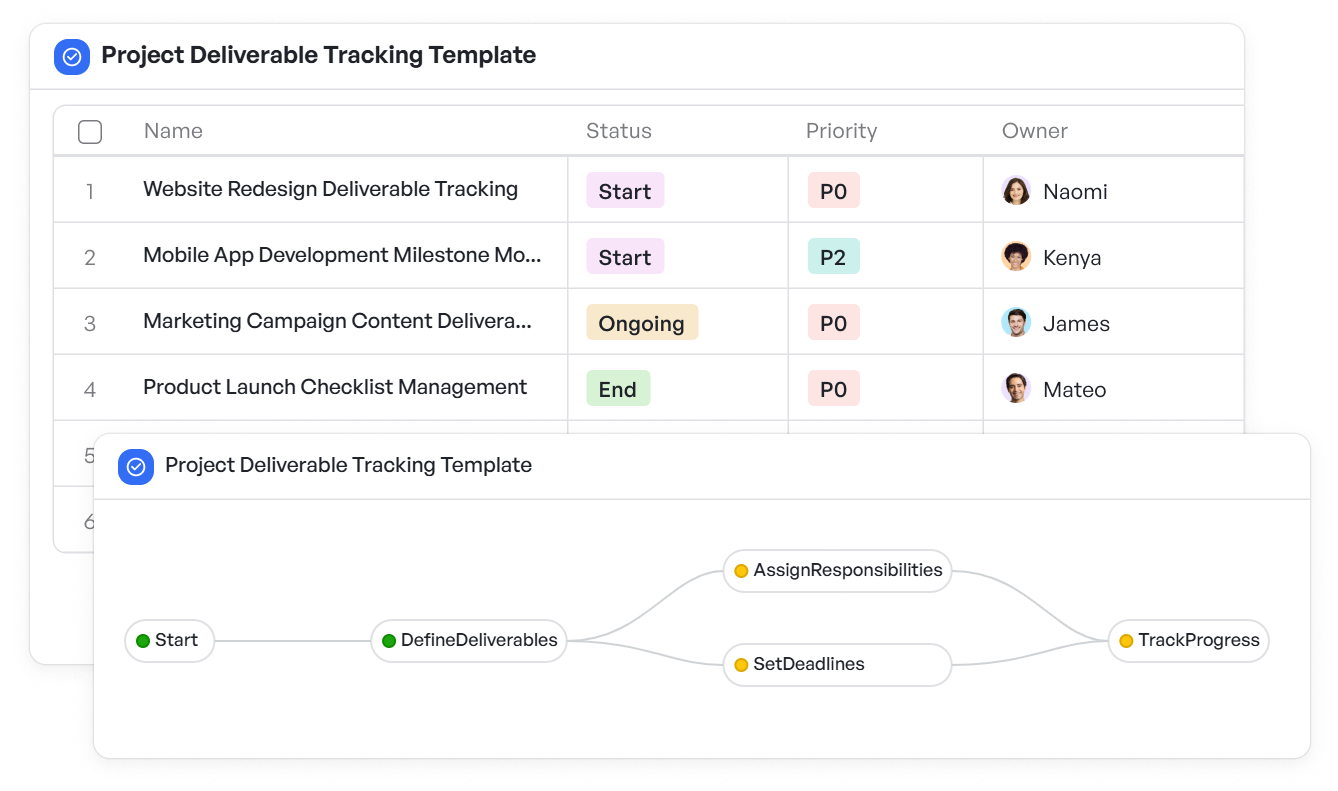 Project managers use a project deliverable tracking template to meet quality standards, ensure timely completion, and align with objectives
Project managers use a project deliverable tracking template to meet quality standards, ensure timely completion, and align with objectivesThe model emphasizes detailed upfront planning, clear documentation, and milestone-based progress tracking. Because each phase builds on the previous one, it helps enforce accountability and scope control, key factors when working with fixed budgets, rigid timelines, or regulated environments.
The methodology closely mirrors the Software Development Life Cycle (SDLC), which follows a progression from requirements gathering to maintenance. The term "Waterfall" reflects how work cascades from one stage to the next, similar to water flowing over a series of ledges, moving in only one direction.
A defining characteristic of the Waterfall model is that each stage has a formal endpoint. Once a phase is closed, teams cannot revisit or modify it without restarting the entire process, which reinforces the importance of getting each step right the first time.
Did you know?
The term ‘Waterfall’ didn’t appear in Winston Royce’s original 1970 paper.
It was coined later by Bell and Thayer in 1976 when they described his diagram as a ‘waterfall of development activities.’
Agile, Kanban, Scrum, Scrumban, Lean and Critical Path Method (CPM) are some of the most popular project management methodologies. Yet, even with so many modern approaches in use, why does the Waterfall methodology still matter?
Let us explore why it still holds its relevance in project management today.
Importance of Waterfall methodology in project management
When a team is assigned to build a medical device application, they are immediately accountable for meeting stringent compliance requirements and ensuring patient safety at every stage. However, the team lacks structured documentation, a defined project plan, and clear role assignments.
Without addressing these gaps, the project cannot move forward. Regulated industries demand exhaustive documentation that outlines every requirement and design decision, both for audit purposes and to meet strict compliance standards.
The Waterfall methodology is particularly well-suited to such environments. Its stage-gated process enforces a disciplined structure where responsibilities, requirements, and timelines are established early and tracked throughout. Every step, from requirement gathering to final testing, is clearly defined, leaving little room for ambiguity or oversight.
 Participant’s preferred approach during the execution phase (Source: Journal of Engineering Research)
Participant’s preferred approach during the execution phase (Source: Journal of Engineering Research)Unlike iterative models that allow for frequent changes, Waterfall prioritizes precision and control. This focus on accuracy helps teams stay aligned, accountable, and efficient, especially when working on safety-critical or compliance-heavy deliverables.
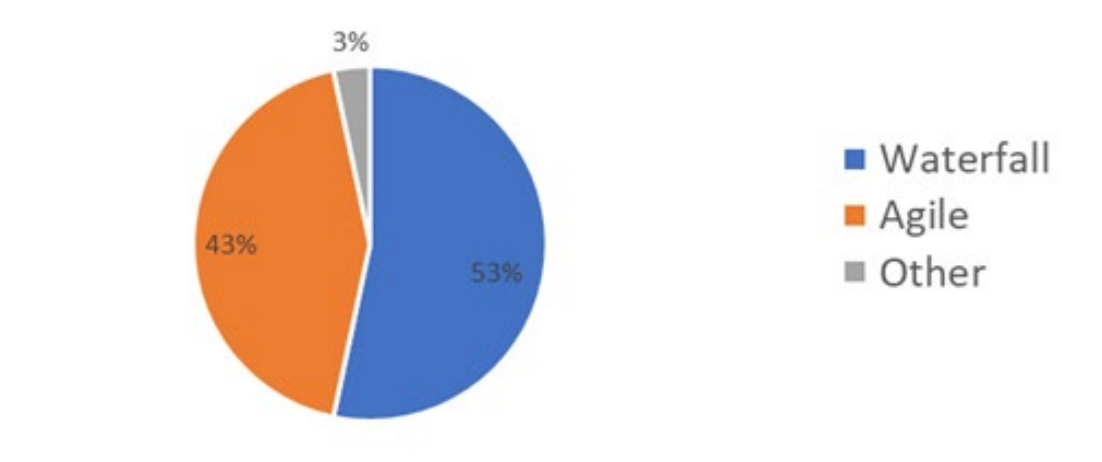 Participant’s preferred approach during the testing phase (Source: Journal of Engineering Research)
Participant’s preferred approach during the testing phase (Source: Journal of Engineering Research)A 2024 article from the Journal of Engineering Research supports this alignment. In a study of project execution practices, 63% of surveyed project managers preferred Waterfall during the execution phase, while 53% favored it for testing. These findings reflect its value in stages that demand consistency, traceability, and minimal deviation.
With its structured progression and rigorous documentation requirements, Waterfall remains a dependable choice for projects where predictability, auditability, and stage-wise approvals are essential.
In the next section, we’ll walk through the individual phases of the Waterfall lifecycle to see how this methodology works in practice.
6 Phases of the Waterfall model in project management
The Waterfall methodology follows a sequential, phase-driven structure. Each stage has defined outputs that serve as inputs for the next, making it easier for teams to maintain clarity, accountability, and progress tracking.
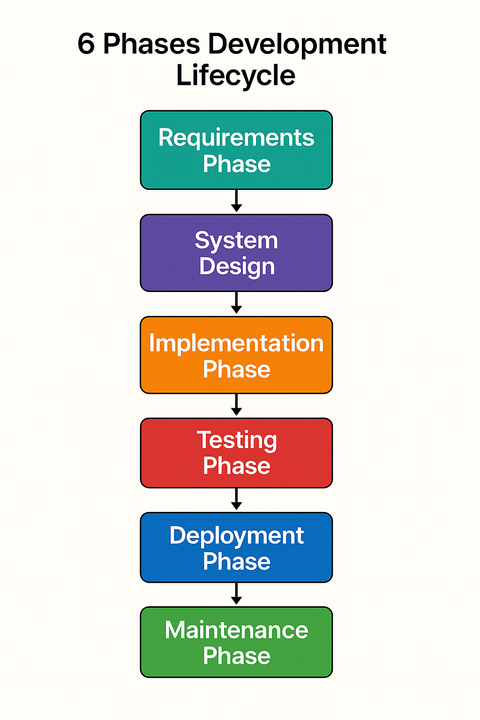 6 phases of Waterfall methodology in project management
6 phases of Waterfall methodology in project managementBelow is a breakdown of the six key phases, starting with the foundation: the Requirements phase.
Phase 1: Requirements phase
The Requirements phase sets the groundwork for the entire project. It defines the “what” and “why” before any planning or execution begins. Teams collect detailed input from stakeholders, translate business needs into clear objectives, and document expectations to minimize ambiguity later in the lifecycle. Platforms like Meegle streamline this process by offering structured templates for requirement gathering, milestone setting, and ownership mapping.
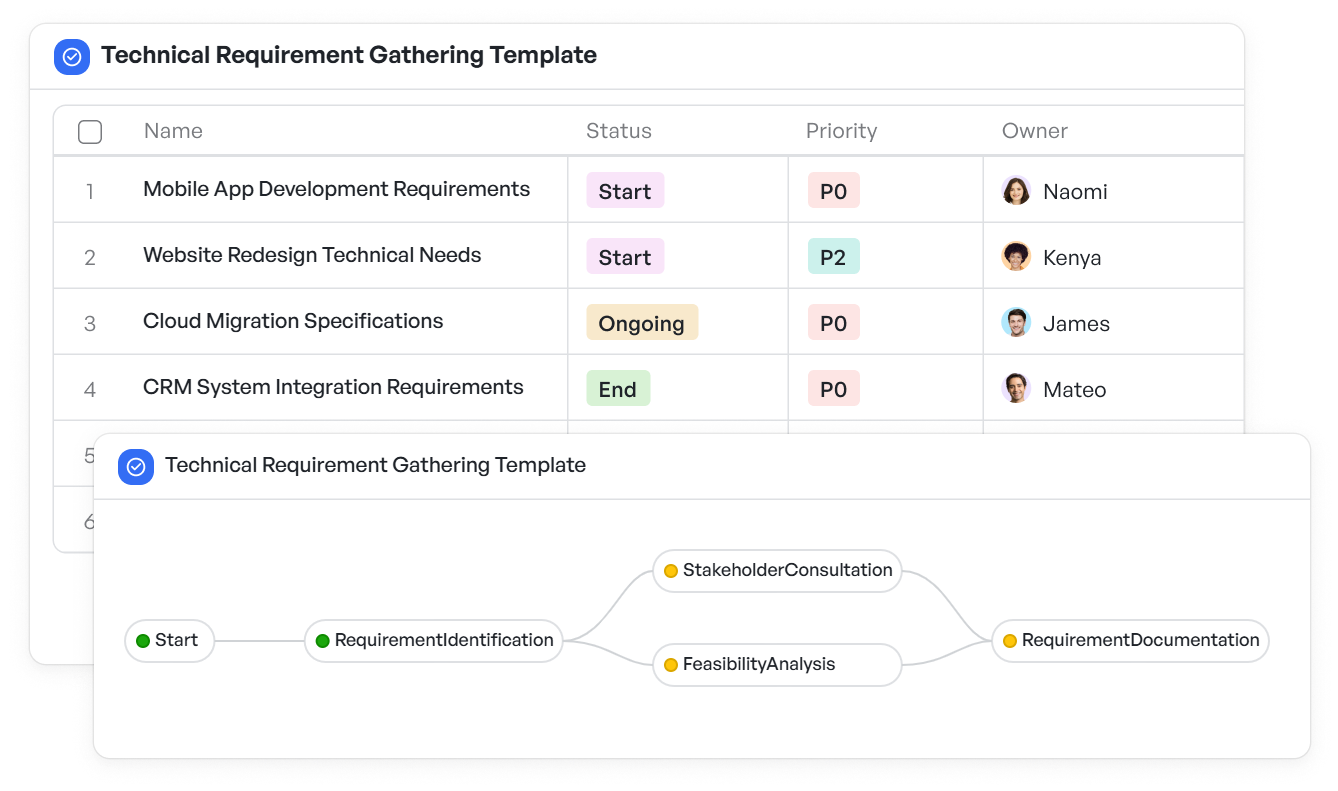 Ensure all stakeholders are aligned on the project’s technical needs to reduce the risk of miscommunication and costly errors
Ensure all stakeholders are aligned on the project’s technical needs to reduce the risk of miscommunication and costly errorsKey activities in this phase include:
- Defining business objectives Project stakeholders articulate the desired outcomes and success criteria. Objectives are broken down into department-specific responsibilities, such as finance tracking budget limits or HR managing resource onboarding, ensuring each team understands its contribution to the larger goal.
- Planning the course of action With objectives in place, teams outline a detailed execution roadmap. This includes sequencing tasks, estimating effort, and identifying dependencies. A clear plan prevents scope creep and establishes accountability for deliverables at each stage.
- Documenting requirements Functional and non-functional requirements are recorded in detail. These documents serve as a shared reference across stakeholders, eliminating misinterpretation and reducing the risk of rework. Requirements may cover system features, integration needs, compliance checkpoints, or usability expectations.
- Defining the testing strategy Teams establish how success will be measured during and after implementation. This involves identifying KPIs, selecting test methods, scheduling test cycles, and assigning responsibility for validation. A robust testing plan helps teams evaluate whether the project delivers on its intended goals.
How Meegle supports the requirements phase
Meegle equips project teams with a set of integrated tools that streamline each step of the requirements phase, ensuring clarity, alignment, and accountability from the outset.
- High-level objectives can be created and assigned directly to relevant departments, such as Human Resources, Finance, or Engineering, using Meegle’s level management feature. This assignment structure helps teams understand their specific responsibilities and align their efforts with overall business goals.
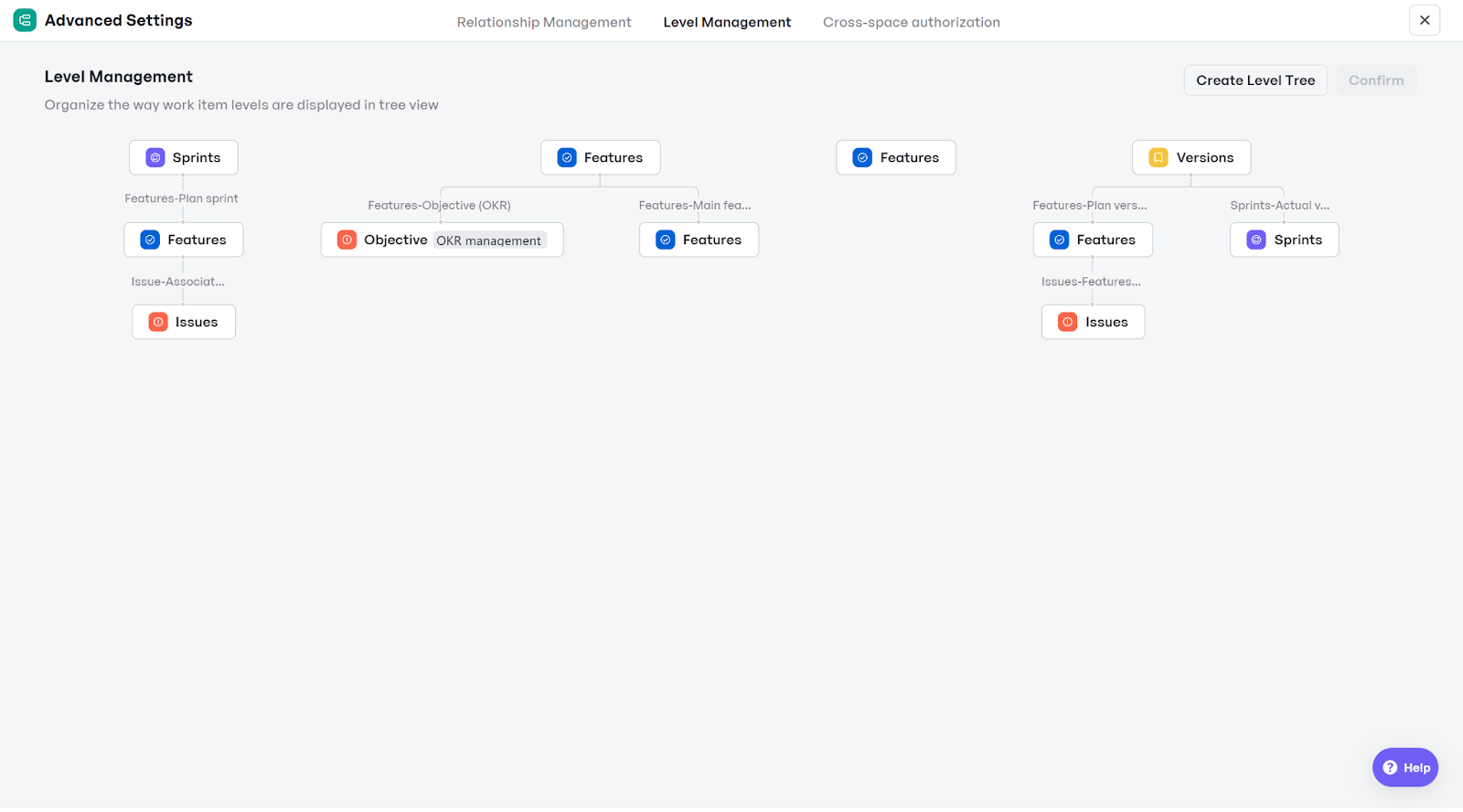 Define and visualize business objectives by breaking them into actionable work items
Define and visualize business objectives by breaking them into actionable work items- The Visual Workflow Builder allows teams to map out the entire Waterfall sequence, from requirement gathering to deployment. This step-by-step visualization helps identify task dependencies, reinforce cross-functional collaboration, and clarify the sequence of activities across departments.
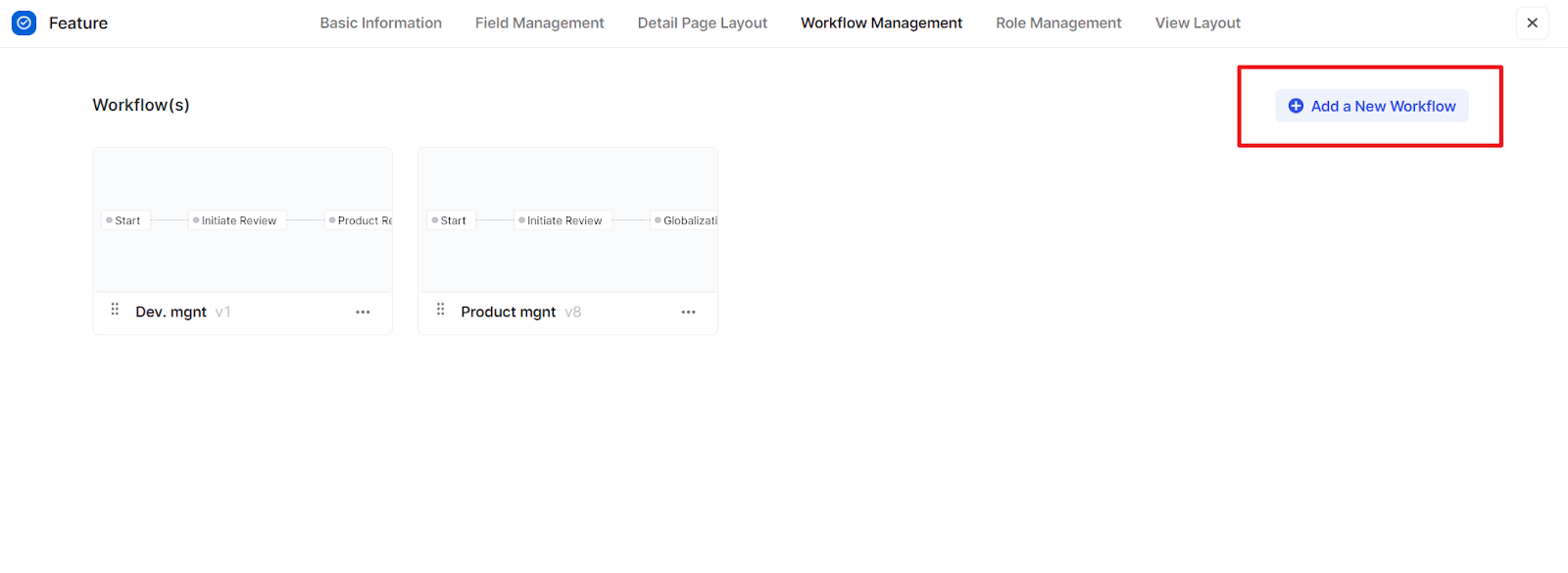 Click on ‘Add a New Workflow’ button to easily set up project roadmaps
Click on ‘Add a New Workflow’ button to easily set up project roadmaps- Teams can embed Lark Docs directly within the Meegle interface to collaboratively draft, edit, and manage project documents. These documents can be linked to specific workflow stages, ensuring everyone is working with the most current information and eliminating the risk of version conflicts
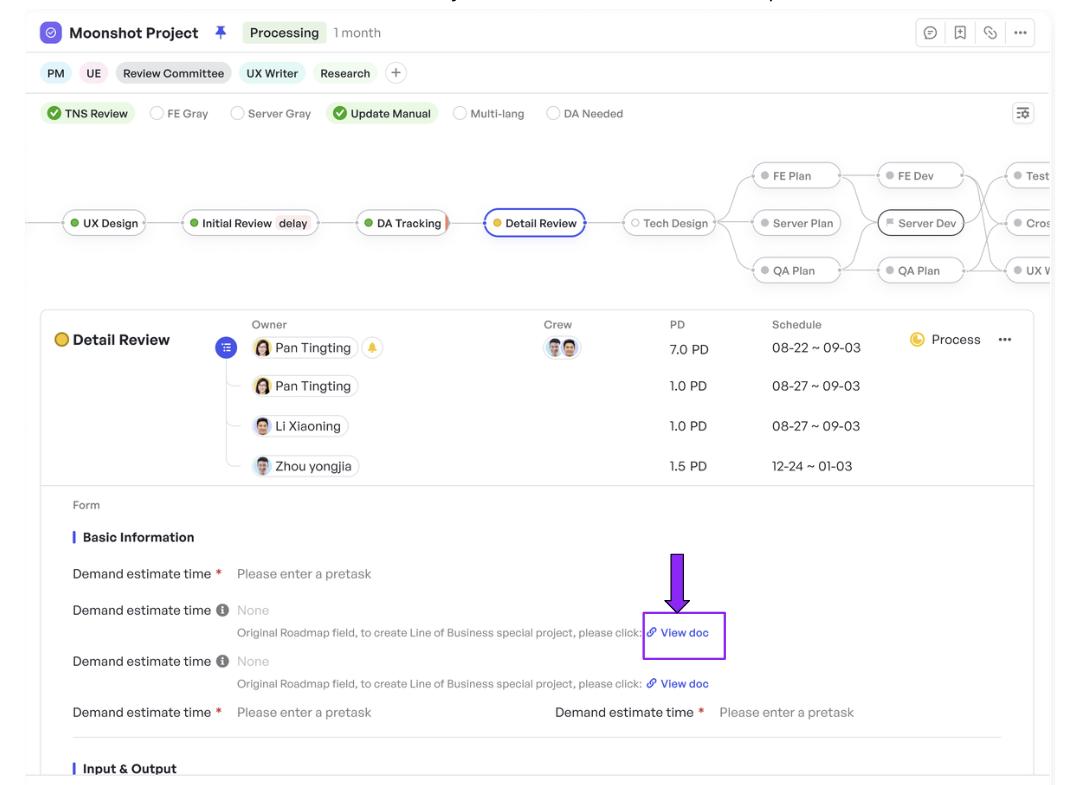 Link, sync, and collaborate effortlessly with Meegle’s integration of Lark Docs
Link, sync, and collaborate effortlessly with Meegle’s integration of Lark Docs- Meegle’s milestone management feature allows teams to define success criteria for each project phase. Within the platform, users can assign test owners, upload test case documentation, and schedule validation timelines, ensuring clear checkpoints for performance measurement and approval.
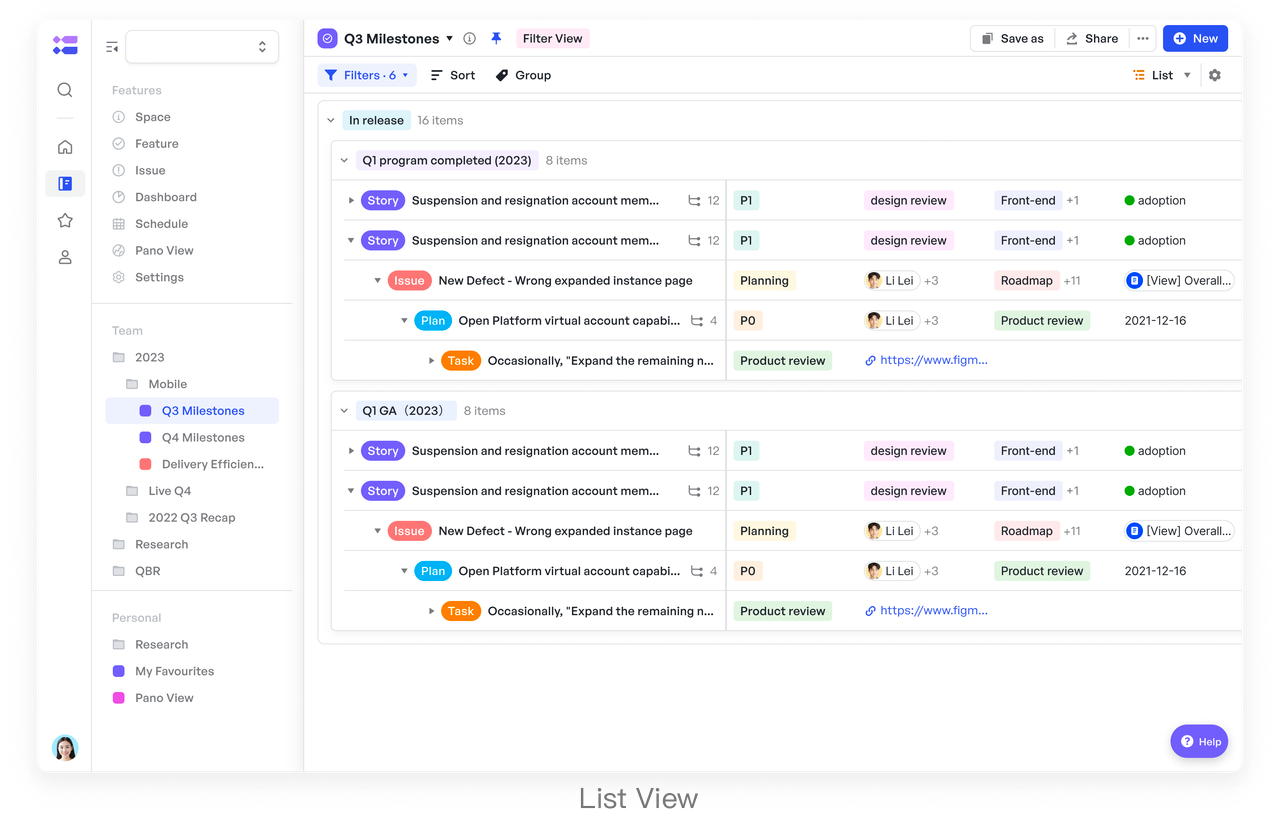 Set success criteria, assign owners, track KPIs, and ensure project alignment
Set success criteria, assign owners, track KPIs, and ensure project alignmentTogether, these features make the requirements phase more structured and measurable, enabling teams to move into the design stage with a strong foundation.
Step 2: System design phase
Once stakeholder requirements are documented and approved, the next step is to translate those inputs into a technical blueprint. The system design phase defines the structure, components, and user experience of the final product, serving as a guide for the development team.
Meegle simplifies this stage through its system design template. Teams can use it to define architecture, document technical specifications, identify dependencies, and set design-phase milestones, all in one place.
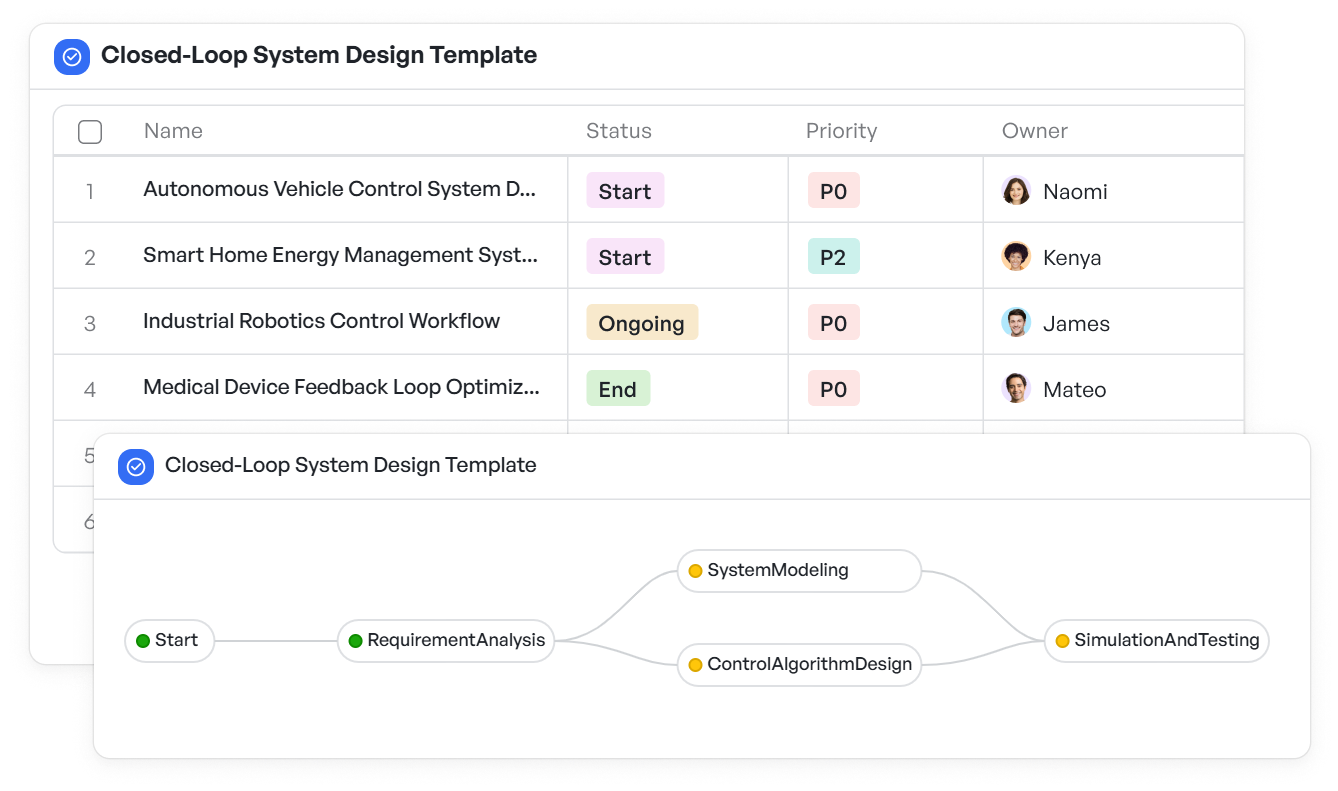 Streamline architecture planning, component mapping, and responsibility assignment
Streamline architecture planning, component mapping, and responsibility assignmentKey activities in this phase include:
- Selecting technology stack The team evaluates and selects the appropriate programming languages, frameworks, and tools based on project goals, performance needs, and long-term maintainability. For each technology chosen, documentation must justify its relevance, use cases, and integration points with other systems.
- Designing system architecture With the tech stack finalized, teams map out how various system components will interact. Both high-level architectural diagrams and detailed component-level designs are developed to support alignment across developers, QA, and non-technical stakeholders.
- Planning user interface and user experience UI/UX planning begins with creating user personas and journey maps based on user research. Teams then develop wireframes that reflect layout, navigation, and interaction flows. These artifacts ensure the design aligns with user expectations and business requirements before moving into implementation.
- Defining data flow Engineers collaborate with security and compliance teams to model how data will move through the system. This includes identifying data entry points, transformation rules, storage mechanisms, and access controls. Clear data flow diagrams reduce integration errors and ensure that both performance and security requirements are met.
How Meegle supports the system design phase
Meegle provides a structured environment for managing design-stage activities by enabling centralized access to technical assets, design artifacts, and cross-functional inputs.
- Requirement specifications, technical evaluations, and architecture notes can be uploaded and directly linked to corresponding nodes in the workflow. This setup ensures that all reference materials are tied to specific stages, allowing team members to access relevant documents without navigating away from the execution plan.
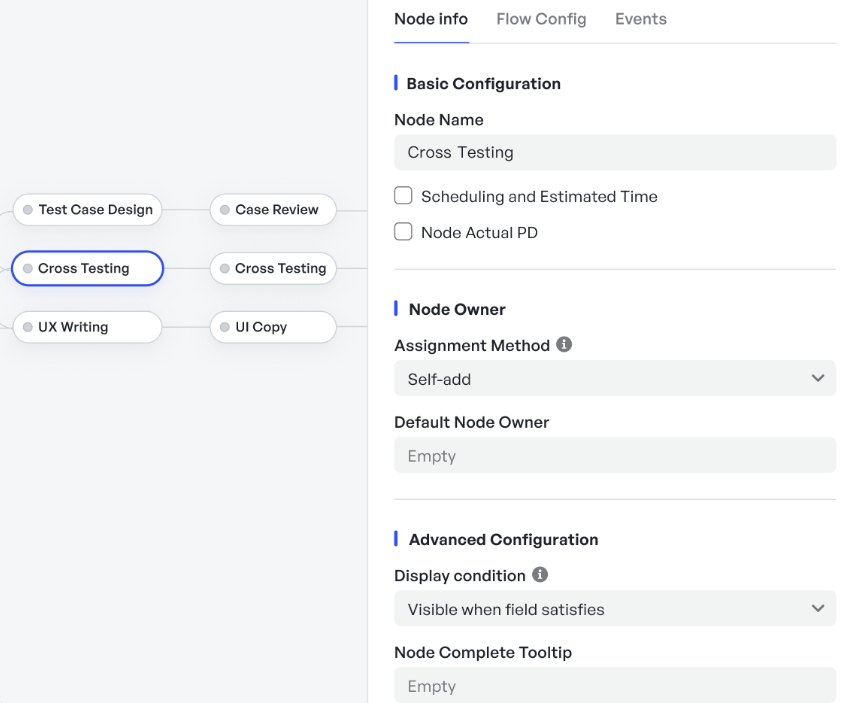 Visualize system architecture and component interactions with Meegle's intuitive drag-and-drop workflows
Visualize system architecture and component interactions with Meegle's intuitive drag-and-drop workflows- Teams can upload design files, wireframes, and interface drafts using the Lark Docs integration within Meegle. The platform supports inline annotations and threaded comments, enabling structured feedback from designers, developers, and product leads. Built-in version control ensures that updates are tracked and earlier iterations remain accessible for audit or rollback if needed.
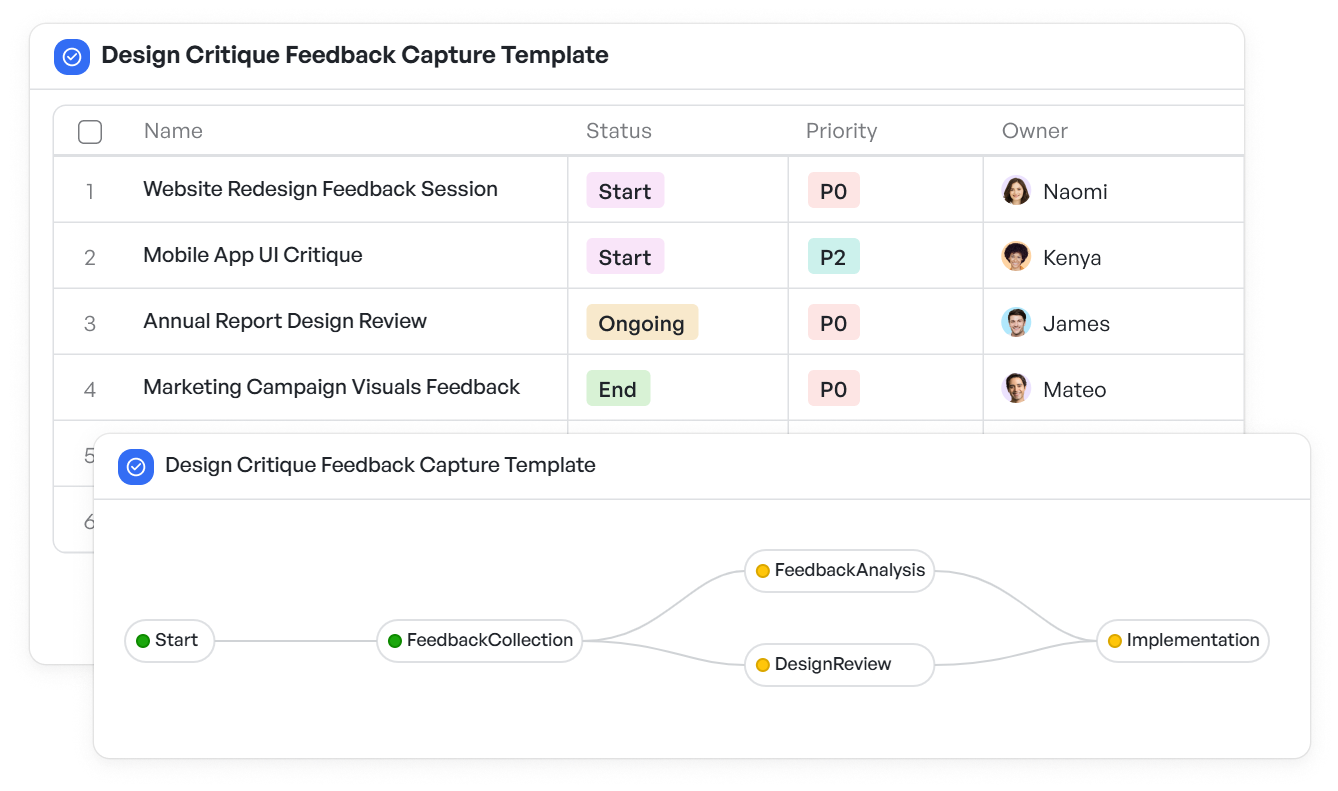 Gather and centralize feedback effortlessly with Meegle’s design critique feedback capture template
Gather and centralize feedback effortlessly with Meegle’s design critique feedback capture template- While Meegle doesn’t function as a dedicated data modeling platform, its node-based workflow system allows teams to map out data handoffs across teams and systems. Nodes can be labeled as APIs, storage units, or validation points to visualize the high-level flow of data and clarify responsibilities across the architecture.
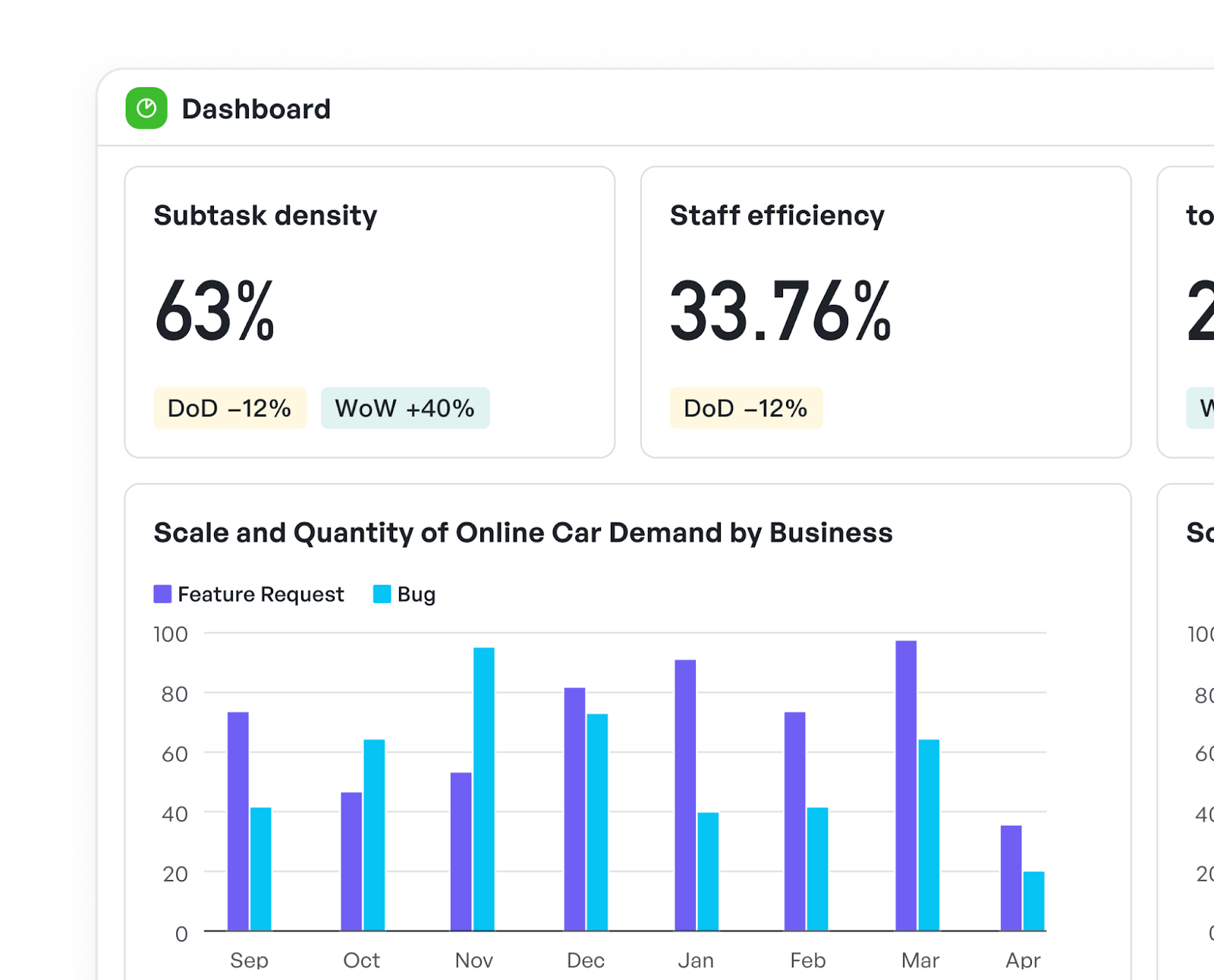 Visualize data flow and uncover critical insights
Visualize data flow and uncover critical insightsThese capabilities enable teams to maintain alignment, streamline handoffs, and preserve design intent as the project progresses into the development phase.
Step 3: Implementation phase
The implementation phase marks the transition from planning to execution. Development teams begin translating the system design and requirement specifications into functional code. Using predefined architecture and technical documentation as reference points, engineers build each software module according to scope and sequence.
Code is developed in structured increments, often aligned with the workflow steps outlined earlier. During this phase, developers also conduct unit testing to verify that individual components function as intended and meet acceptance criteria. These tests help catch issues early and ensure each module integrates smoothly into the larger system.
By the end of this phase, the project evolves from static designs into a working application with foundational features in place, ready for integration and validation in the subsequent testing stage.
How Meegle supports the implementation phase
Meegle enables structured task execution during implementation by offering granular visibility, clear ownership, and traceable progress tracking.
- Each development task or module can be represented as a node within the workflow. These nodes are assigned to individual team members, with defined owners, schedules, and attached documentation, ensuring that everyone knows what they’re responsible for and when it’s due.
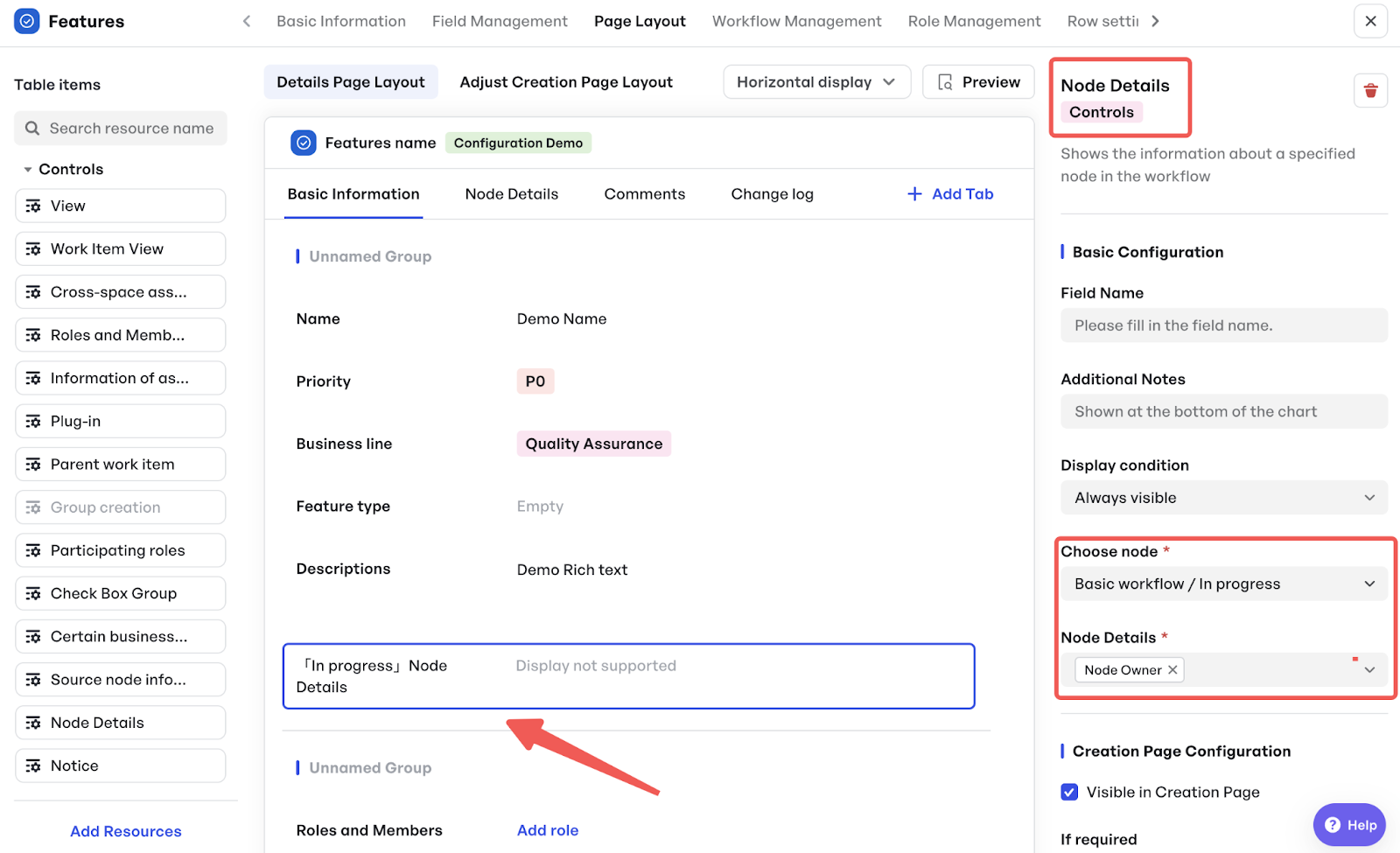 Assign owners to enhance task accountability and streamline project management
Assign owners to enhance task accountability and streamline project management- Larger development efforts can be broken down into subtasks directly within a node. This allows teams to manage dependencies, distribute workloads more evenly, and track completion status at a detailed level, ideal for projects with multiple layers of implementation.
- Project leads can monitor active, completed, and delayed tasks in real time. The platform highlights schedule variances and bottlenecks early, enabling faster intervention to keep the development cycle on track.
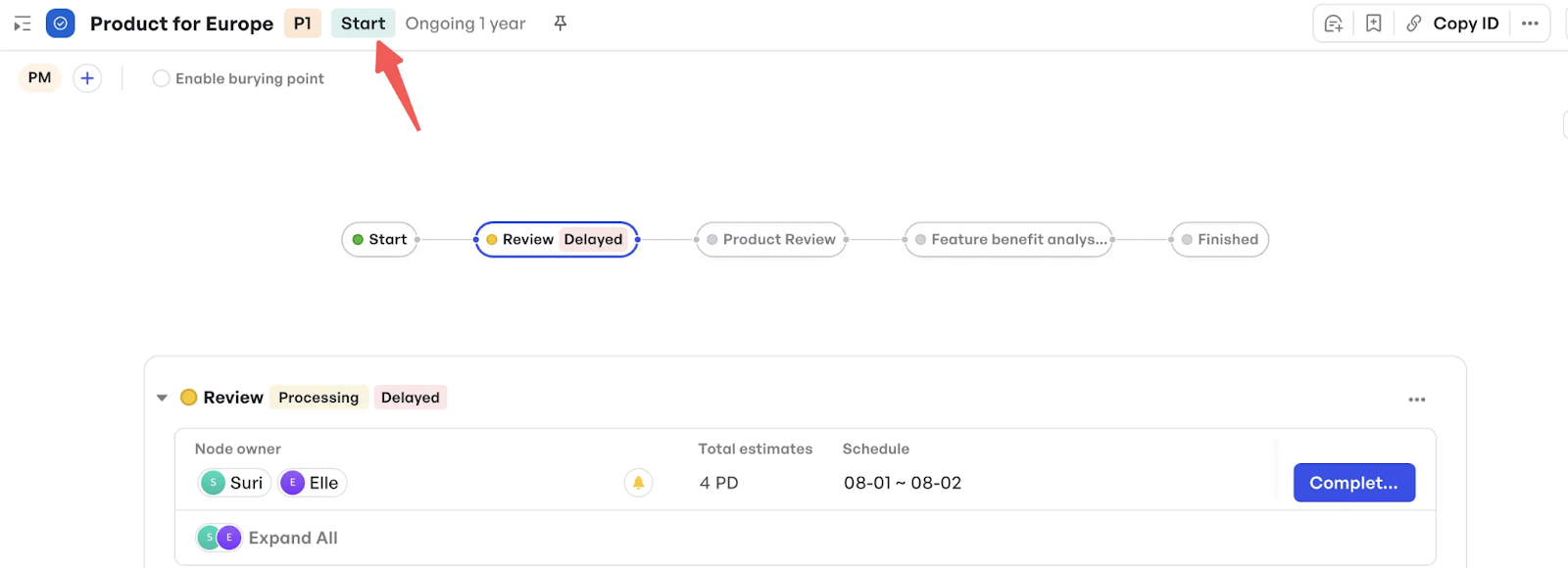 Monitor ongoing and delayed tasks, ensuring projects stay on track and deadlines are met
Monitor ongoing and delayed tasks, ensuring projects stay on track and deadlines are met- Test cases can be linked directly to corresponding development nodes. Assigned test owners receive notifications, and test results can be logged within the same workflow. This creates a closed feedback loop between development and quality assurance, preserving traceability and ensuring validation steps are completed as planned.
These features allow engineering teams to execute against design specifications with structure, accountability, and built-in quality checks.
Step 4: Testing phase
Once development is complete, the project moves into the testing phase, where quality assurance (QA) teams evaluate the software against the original requirements and technical specifications. The goal is to identify and document any defects or inconsistencies before deployment.
QA testers execute predefined test cases and validate functionality, performance, and compliance. When issues are found, they are recorded with complete details, including steps to reproduce, logs, and screenshots, to support faster debugging and prevent recurrence.
Well-maintained defect documentation serves as a future reference, helping new developers resolve similar issues without starting from scratch. In this context, testing documentation functions as a practical playbook for issue resolution and quality control.
How Meegle supports the testing phase
Meegle enables structured, transparent, and traceable QA workflows by combining test management, bug tracking, and collaborative documentation.
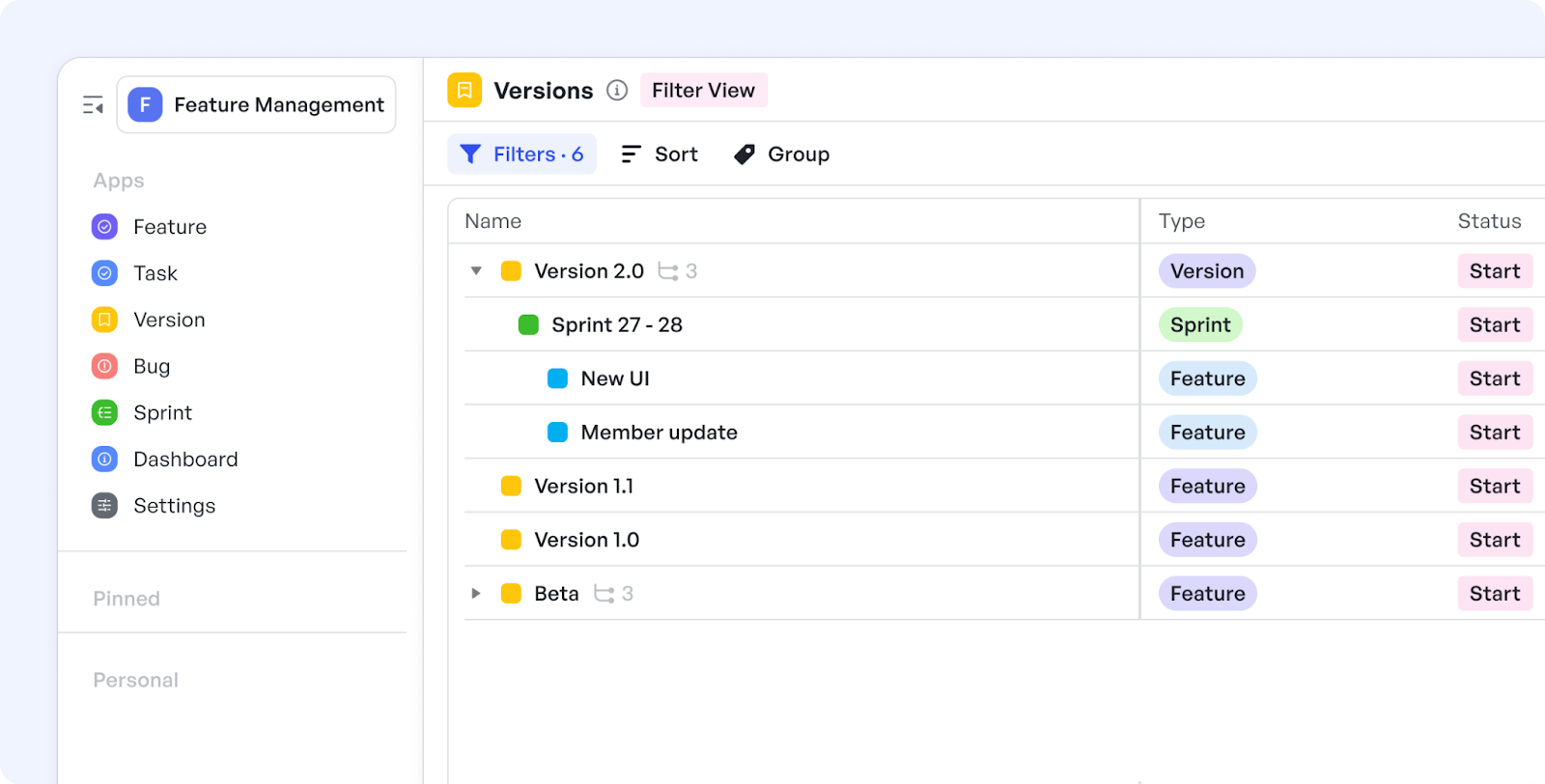 Track bugs and features with the feature management template, providing clear context for developers
Track bugs and features with the feature management template, providing clear context for developers- QA teams can log bugs directly within the relevant module or task node. Each issue is tied back to specific requirements or implementation steps, maintaining traceability across the project lifecycle.
- Meegle’s feature management template allows testers to track bugs alongside active features. Developers receive clear context about where the issue occurred, how it affects functionality, and what component needs revision.
- Testers can create detailed reports containing logs, screenshots, test results, and remediation notes, all linked to the associated task or subtask. This centralized documentation improves visibility and accelerates the developer response time.
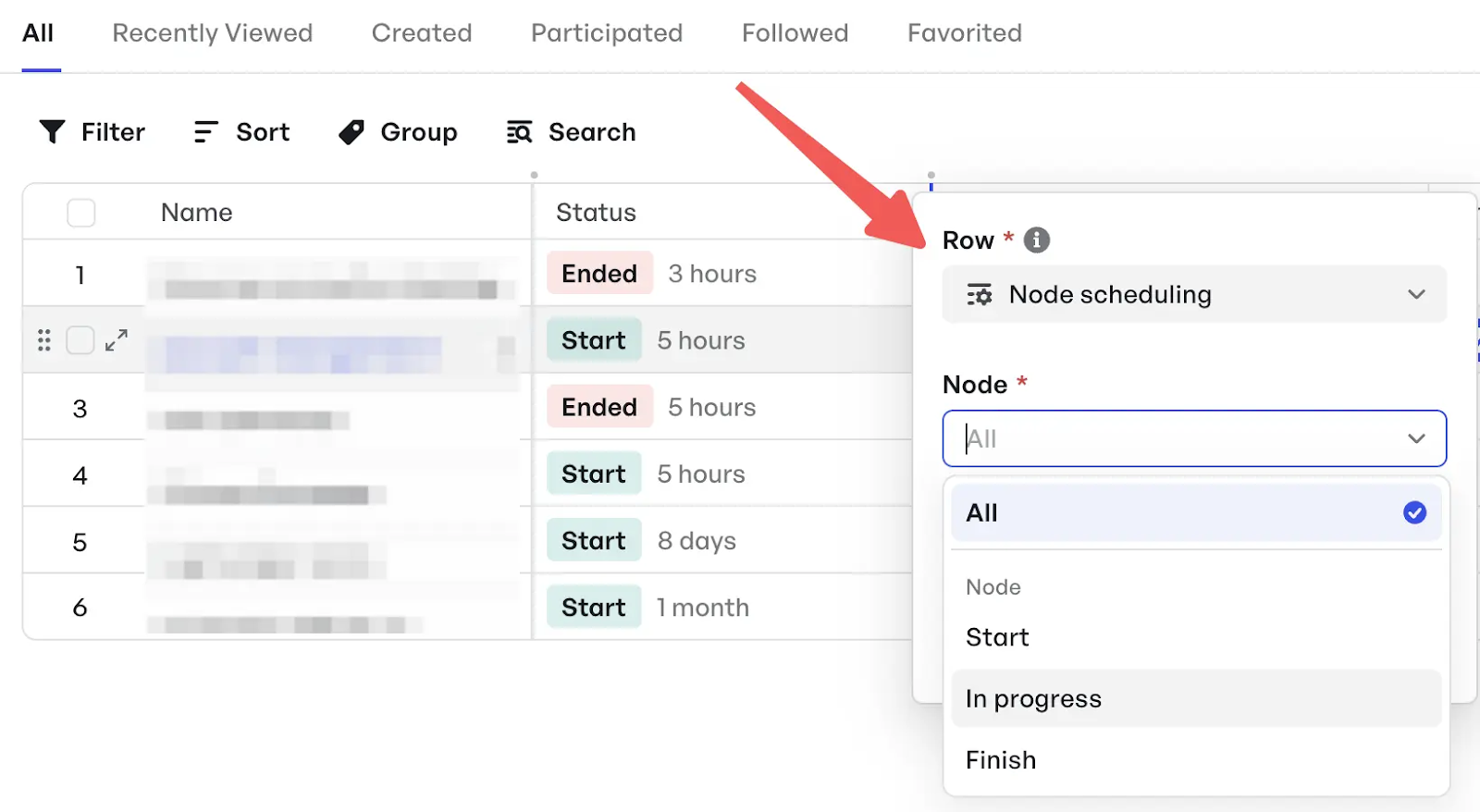 Track test cases with clear statuses: Start, In progress, and Finished for seamless progress monitoring
Track test cases with clear statuses: Start, In progress, and Finished for seamless progress monitoring- Test cases are assigned to individual QA owners with defined priority levels and real-time status updates, such as Start, In Progress, or Finished. This structured approach ensures all stakeholders can monitor testing progress at a glance.
- Every change, bug update, and resolution is automatically logged in an audit trail. This feature provides a comprehensive history of test activities, supporting compliance checks and continuous improvement efforts.
Together, these capabilities help teams conduct thorough testing, maintain project integrity, and ensure readiness for deployment.
Step 5: Deployment phase
The deployment phase marks the official release of the final deliverable. In software development, this is when the application is launched for end users. In other industries, such as manufacturing, construction, or healthcare, it involves delivering the completed solution or product to the customer.
A smooth deployment depends on advanced coordination across departments, clear communication with stakeholders, and real-time visibility into rollout activities. Teams must verify readiness, execute final checks, and ensure that all supporting materials (like documentation, onboarding guides, or release notes) are prepared and distributed.
How Meegle supports the deployment phase
Meegle provides tools to orchestrate the final rollout with clarity and accountability, ensuring all teams and stakeholders are aligned throughout the deployment process.
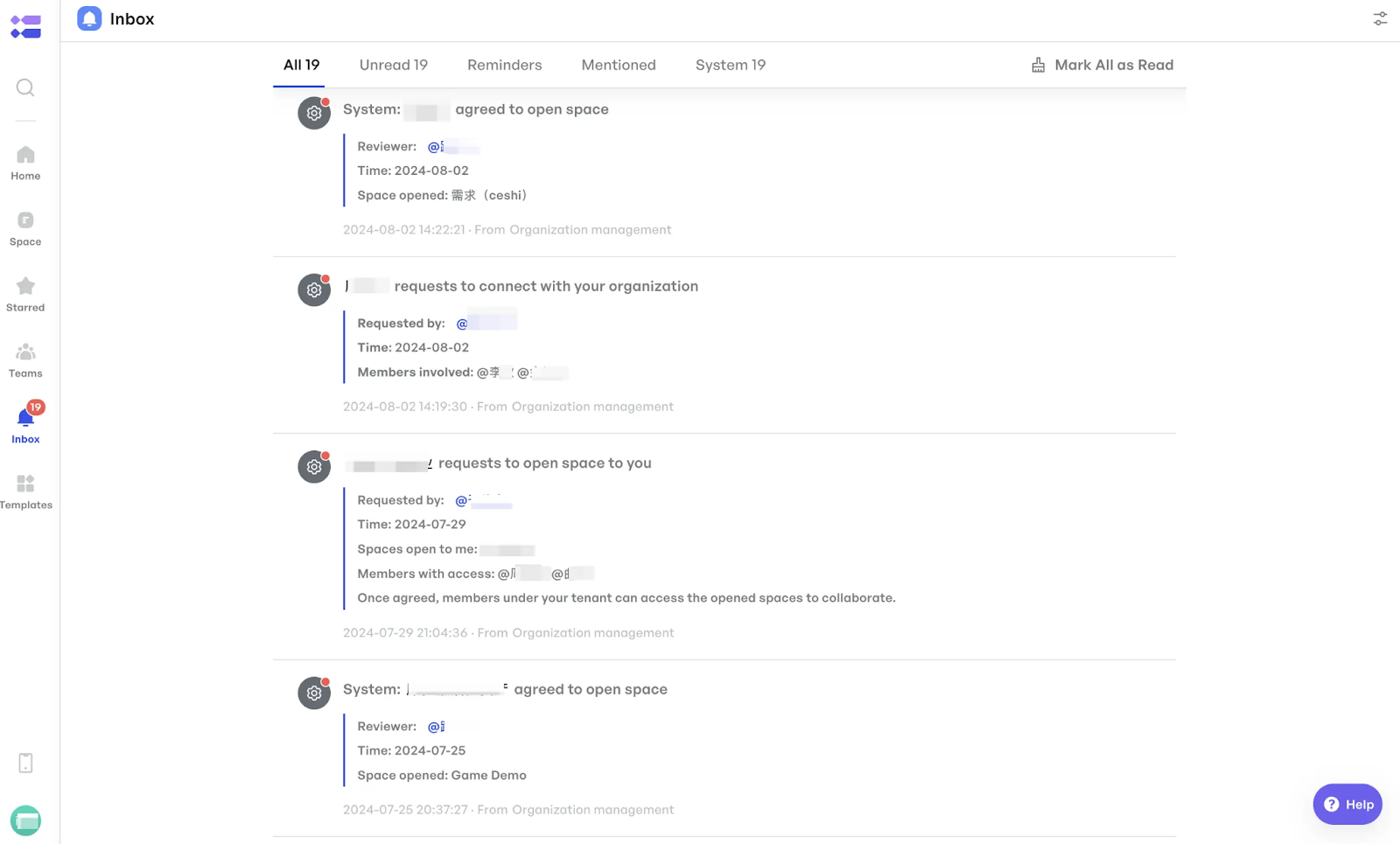 Stay informed with Meegle’s inbox, ensuring stakeholders are alerted at every key milestone
Stay informed with Meegle’s inbox, ensuring stakeholders are alerted at every key milestone- Meegle’s built-in notification system automatically alerts internal and external stakeholders, such as operations, customer support, or clients, ahead of each deployment milestone. This allows teams to prepare for launch-related tasks like customer communication, environment setup, or post-release support.'
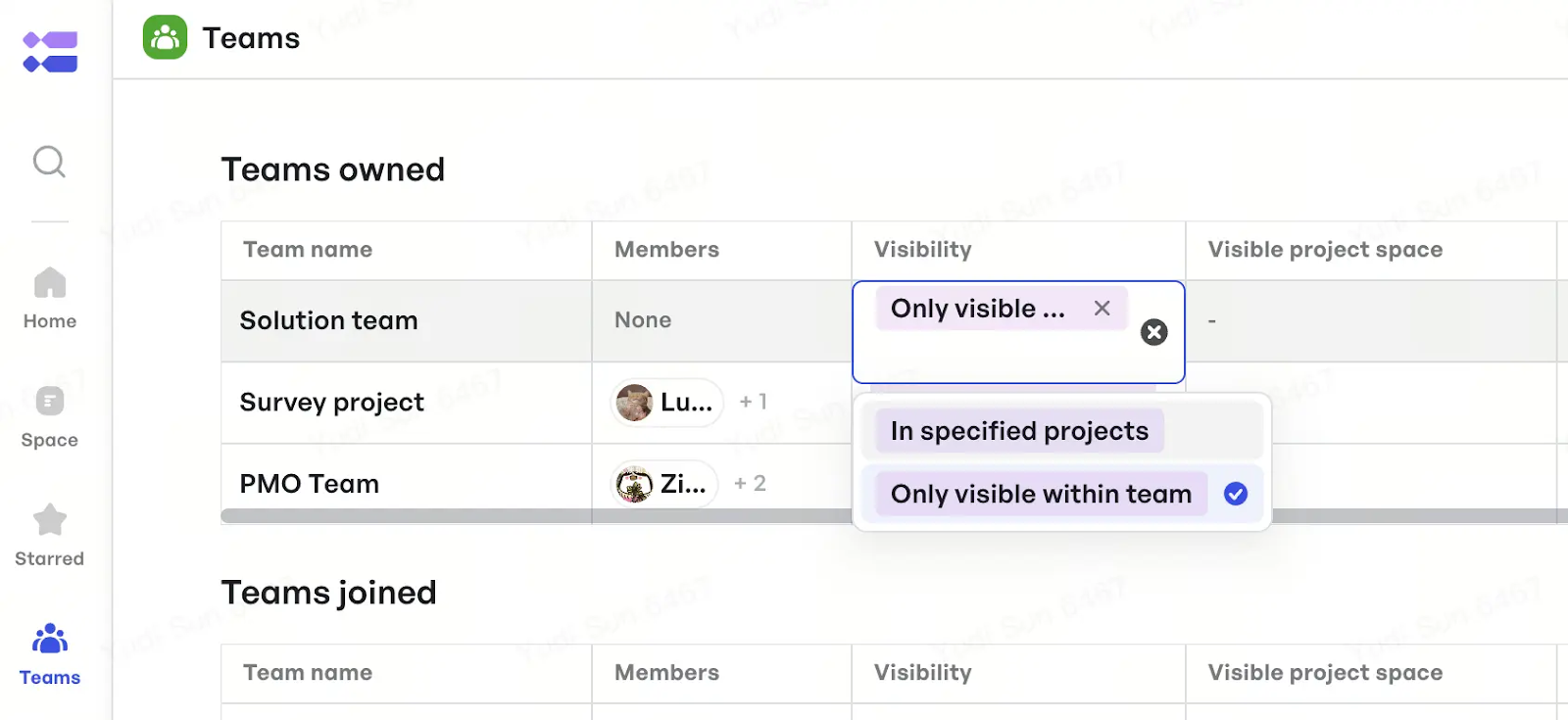 With 'In specified projects' and 'Only visible within the team' options, ensure tailored visibility for real-time action items and rollout status
With 'In specified projects' and 'Only visible within the team' options, ensure tailored visibility for real-time action items and rollout status- All teams, regardless of function, access the same real-time visual dashboard. Whether it’s development, QA, client services, or project leadership, everyone works from a single source of truth, which reduces misalignment and accelerates decision-making during time-sensitive launch windows.
By combining automated alerts and unified visibility, Meegle helps project teams execute deployments efficiently, minimize rollout risks, and keep stakeholders fully informed.
Step 6: Maintenance phase
After deployment, the project enters the maintenance phase, where teams handle defect fixes, enhancement requests, and system updates. User feedback, compatibility issues, and evolving business needs often trigger changes that require ongoing monitoring and controlled releases. A dedicated team is typically responsible for managing these changes, issuing patches, and rolling out new software versions to keep the system functional and relevant.
How Meegle supports the maintenance phase
Meegle helps teams manage the maintenance cycle with structured workflows that link every request to its origin and track progress through each update.
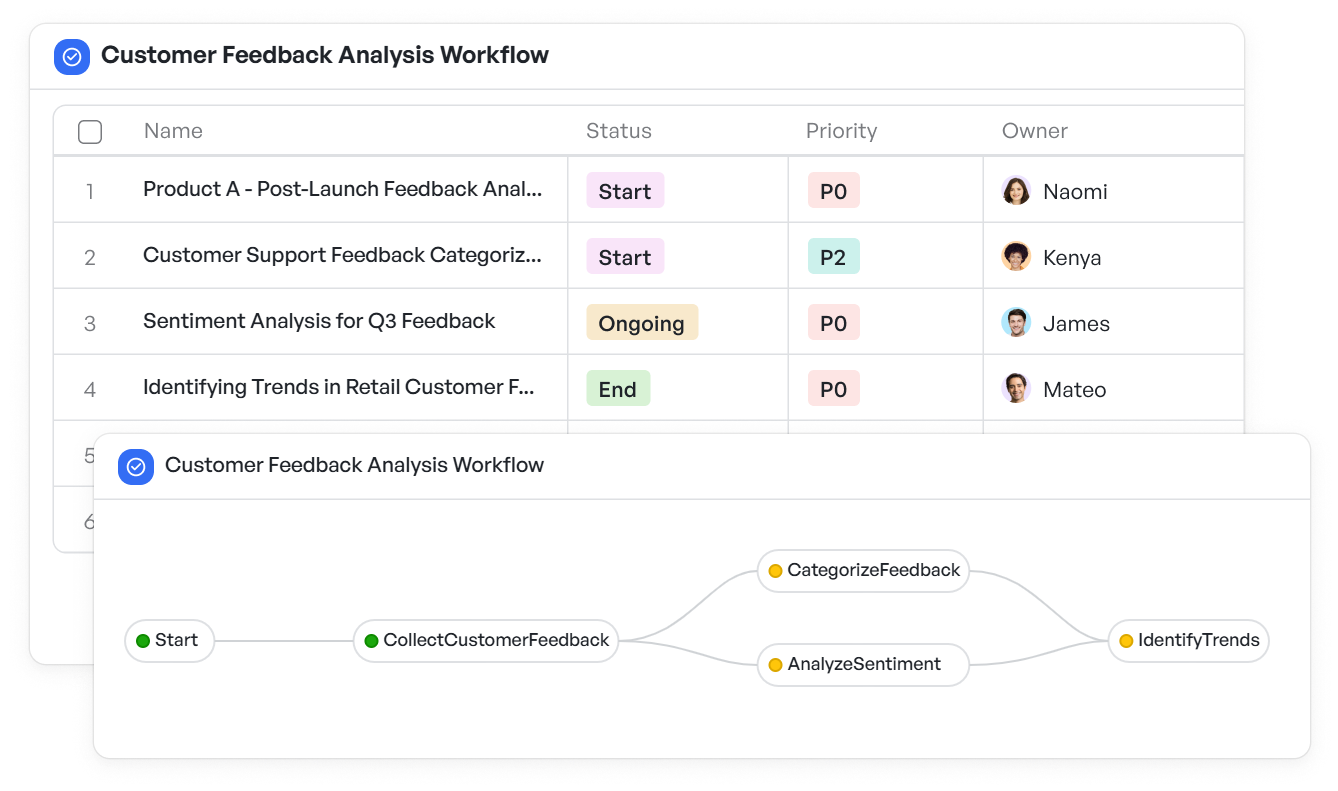 Use the customer feedback analysis workflow template to track, categorize, and act on user feedback for continuous improvement
Use the customer feedback analysis workflow template to track, categorize, and act on user feedback for continuous improvement- New change requests or defect reports can be logged directly in Meegle and categorized by type, urgency, or affected module. Each request is mapped back to the relevant requirements or development components, making it easier to assess impact and assign resolution teams.
- Meegle maintains a complete version history across tasks and modules. Teams can track all updates, review what changes have been made, and, if necessary, initiate rollbacks to a previous stable version, ensuring system reliability during hotfixes or regressions.
- Customer feedback can be logged into the system and converted into actionable tasks. These are linkable to either active sprints or Waterfall-based workflows, enabling teams to prioritize and address them systematically.
 Use the Project Life Cycle template to manage and track every phase of your project from start to finish
Use the Project Life Cycle template to manage and track every phase of your project from start to finish- The customer feedback analysis template allows teams to monitor user input, tag recurring issues, and assign follow-ups.
Combined with Meegle’s Project Lifecycle (PLC) template, teams can manage and monitor all six phases of the Waterfall model, ensuring continuity and alignment throughout the entire project timeline.
What are the 3 core principles of the Waterfall methodology?
Before selecting a project management methodology, it is essential to evaluate whether its structure aligns with your team’s operational rhythm and stakeholder expectations. The Waterfall model is built on three foundational principles that shape how projects are planned, executed, and delivered.
 Waterfall’s principles: sequence, minimal customer input, and thorough documentation (Source: Management.org)
Waterfall’s principles: sequence, minimal customer input, and thorough documentation (Source: Management.org)- Sequential execution The Waterfall methodology follows a strict linear sequence, each phase must be completed and signed off before the next begins. This structure enforces discipline and prevents overlapping work. Once a stage is closed, teams do not revisit it unless a major revision is required, which ensures continuity and avoids rework.
- Limited customer involvement mid-project Stakeholder interaction is front-loaded and end-loaded. Customers provide input during the initial requirements-gathering phase and later during final delivery or acceptance testing. The development and design stages operate with minimal client input, which means teams must rely on early specifications to guide every decision.
- Comprehensive documentation Waterfall projects require detailed documentation at every stage, from requirement specifications and architectural designs to test plans and validation records. Since real-time customer feedback is limited, this documentation becomes the primary reference for developers, testers, and compliance reviewers throughout the lifecycle.
Understanding these principles is key to determining whether Waterfall is the right fit for your project. In the next section, we’ll explore the practical advantages it offers and when to apply it for best results.
4 Benefits of Waterfall methodology in project management
The January–March 2023 issue of the International Journal of Innovations and Research Analysis (IJIRA) highlights the Waterfall model’s value across structured software development projects. The research outlines key advantages that make this methodology a strong choice for teams operating in regulated, deadline-driven environments.
- Well-defined project structure: Waterfall’s phase-based progression offers a clear roadmap from initiation to delivery. Project managers can allocate resources, estimate task durations, and set measurable milestones with confidence. The defined boundaries between stages help eliminate ambiguity, making it easier to monitor task status and team contributions.
- Predictable timelines and deliverables: Since Waterfall limits scope changes after the requirements are finalized, delivery schedules can be established early in the process. This predictability helps product managers align with stakeholder expectations, communicate delivery targets, and manage project risks more effectively, particularly in fixed-scope engagements.
- Fixed and stable requirements: Waterfall is most effective when the scope is locked before development begins. With requirements gathered and approved upfront, teams avoid scope creep, plan development cycles more accurately, and reduce the likelihood of mid-project disruptions. This stability supports budget adherence and efficient resource usage.
- Comprehensive documentation: Detailed documentation is maintained at every stage, from requirement definitions and system designs to test plans and deployment logs. These records serve as a single source of truth for all teams involved, supporting regulatory compliance, onboarding of new team members, and future audits or revisions.
These benefits make Waterfall an ideal framework for projects that demand structure, consistency, and traceable execution across clearly defined phases.
3 Disadvantages of Waterfall project management
The SAR Journal (March 2022, Volume 5, Issue 1) presented a comparative case study that outlined several limitations of the Waterfall methodology, particularly in projects where flexibility, speed, and iterative feedback are critical. The study’s data highlights three key challenges project teams often face when using this model.
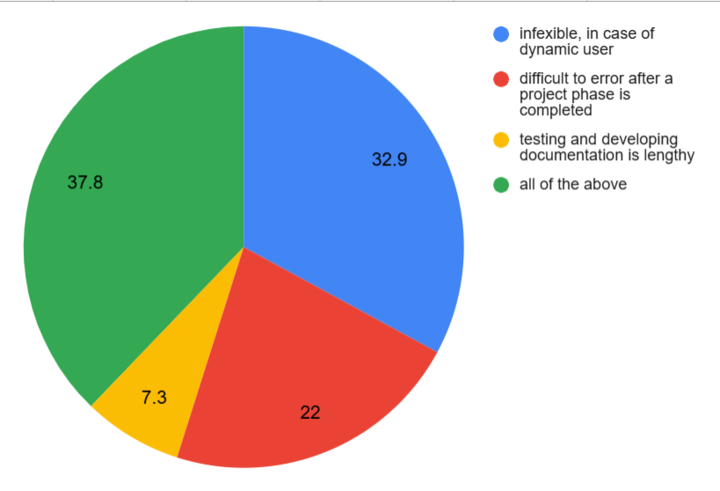 Limitations of Waterfall methodology (Source: SAR Journal (March 2022, Volume 5, Issue 1)
Limitations of Waterfall methodology (Source: SAR Journal (March 2022, Volume 5, Issue 1)- Limited adaptability to changing requirements: Waterfall assumes that all requirements are fully known and fixed at the start. Once the requirements phase is completed, introducing new features or adjusting the project scope becomes difficult and costly. Any major change typically requires restarting the process from the beginning, revisiting documentation, redesigning workflows, and reallocating resources.
- High cost of error correction in later phases: Since the methodology mandates that each phase be completed and approved before moving on, defects discovered during testing or deployment are often traced back to earlier stages. Addressing such issues requires revisiting previously closed phases, increasing both effort and expense. The lack of flexibility makes error resolution more resource-intensive compared to iterative models.
- Delayed testing and cumbersome documentation: Testing activities are deferred until the build phase is complete, which delays the discovery of bugs or misalignments. Combined with the requirement for exhaustive documentation at every step, this often extends project timelines, especially when rapid feedback or incremental validation is needed. While documentation enhances traceability, it can also slow progress in fast-moving environments.
While Waterfall offers control and structure, these drawbacks make it less suitable for projects with evolving requirements, short timelines, or a need for frequent stakeholder input. Comparing it with iterative frameworks like Agile can help teams choose the right approach based on context and constraints.
Check out Meegle's Agile development solution
Best practices for using the Waterfall model
- Establish clear roles, goals, and communication protocols: Before the project begins, define team responsibilities, project objectives, and communication channels. Use kick-off meetings, status reports, and phase reviews to ensure alignment across departments. This reduces misinterpretation and keeps each team accountable to timelines and deliverables.
- Maintain comprehensive, phase-specific documentation: Document every major decision, requirement, and milestone as the project progresses. For example, during the requirements phase, capture business rules and compliance needs in detail. During development, record design logic, technical dependencies, and testing parameters. This ensures continuity when team members change or when the system needs future updates or audits.
- Identify and mitigate risks early: Use a structured risk assessment process during the planning phase. Identify potential blockers, such as resource gaps, regulatory changes, or system dependencies, and assign owners to develop contingency plans. Proactive risk management reduces the likelihood of costly delays or rework later in the project.
- Use project management frameworks for task control: Use structured tools like Gantt Charts to visualize timelines, Work Breakdown Structures (WBS) to define deliverables, and Critical Path Method (CPM) to identify task dependencies. These tools provide clarity on progress, help resolve bottlenecks, and support phase-by-phase planning in line with Waterfall’s structure.
Following these practices allows project teams to execute Waterfall projects with greater precision and resilience, particularly in environments where predictability, documentation, and compliance are non-negotiable.
Waterfall vs. Agile vs. Hybrid Methodologies
Waterfall, Agile, and Hybrid represent three distinct approaches to project management, each suited to different types of projects based on scope, timeline flexibility, and stakeholder involvement. The comparison table below highlights how these methodologies differ across key dimensions:
| Aspect | Waterfall | Agile | Hybrid |
|---|---|---|---|
| Approach | Linear and sequential execution | Iterative cycles (sprints) with adaptive planning | Merges Waterfall’s structure with Agile’s responsiveness |
| Flexibility | Low, changes after a phase are difficult to incorporate | High, welcomes evolving requirements at any stage | Balanced, rigid in some parts, flexible in others |
| Phases | Clearly separated, each completed before the next | Phases overlap and iterate frequently | Uses fixed phases for some tasks, iterative loops for others |
| Timeline | Defined upfront and rarely adjusted | Evolving timeline based on continuous input | Fixed timelines for core components; flexible for variable ones |
| Stakeholder Involvement | Primarily at the start and end of the project | Continuous engagement and feedback throughout | Ongoing participation at varying levels depending on project needs |
| Documentation | Comprehensive at every stage | Minimal, emphasis on working deliverables | Mix of both, detailed for compliance, lean for iterative components |
| Best Suited For | Projects with stable scope and regulatory oversight | Projects with frequent requirement shifts and active users | Projects requiring both control and agility in different workstreams |
Suggested read: 👉Waterfall vs. Agile
Real-world example: Internal billing system
Suppose a company embarks on the development of a new internal billing infrastructure to modernize its financial workflows. In the early stages, the requirements from the finance and sales teams are well-defined, making it suitable to use the Waterfall model. Each specification can be translated into a detailed plan, with clear documentation and timelines.
However, partway through the development, the marketing and customer support teams request functionality that wasn’t captured during initial planning. Waterfall’s linear approach cannot easily accommodate mid-project changes without revisiting earlier phases entirely.
At this point, shifting to Agile becomes necessary. Agile enables the team to adjust priorities, engage with stakeholders more frequently, and incorporate feedback in shorter development cycles.
In many such scenarios, project managers adopt a hybrid model. Core infrastructure and compliance-heavy modules, like payment processing or data privacy, follow Waterfall’s structured phases. Simultaneously, user interface enhancements or integration features adopt Agile workflows to iterate based on evolving input.
This blended approach allows teams to maintain control over critical elements while staying adaptable in fast-moving areas.
For projects with a mix of rigid deliverables and evolving features, Hybrid methodology offers the flexibility and governance needed to stay aligned with business goals while responding to real-time user needs.
Suggested read: 👉Hybrid project management vs. Waterfall
Practical example of the Waterfall model in project management
Let’s look at how the Waterfall methodology was applied to develop a payroll system for a multinational corporation. The project involved multiple internal stakeholders across regions, each operating under distinct payroll regulations and compliance mandates.
The project began with a cross-functional effort to collect and document payroll requirements from departments such as Finance, HR, and Legal. Using Meegle’s payroll system requirements gathering templates, the team was able to organize region-specific tax rules, payment cycles, and employee classifications into a unified scope. This helped eliminate ambiguity and aligned all departments before any technical planning began.
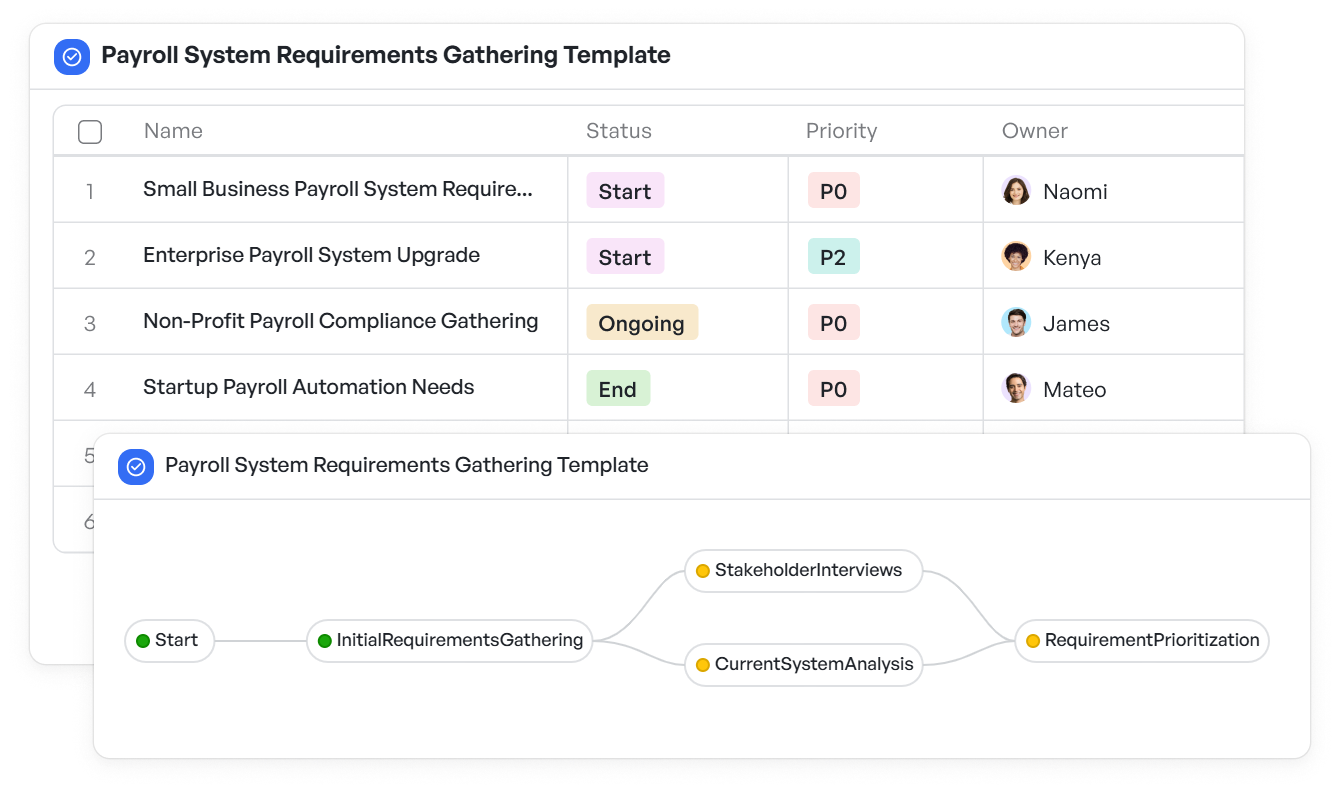 Gathers and organizes requirements, making sure the project starts with a clear understanding
Gathers and organizes requirements, making sure the project starts with a clear understandingOnce the business and regulatory needs were locked, the engineering team used Meegle’s workflow builder to design the system architecture. Key modules, like tax computation, multi-currency support, and reporting, were mapped to dedicated nodes, each with assigned owners and test checkpoints.
Because Waterfall enforces phase completion before moving forward, development and testing followed a strictly sequenced path. The design was implemented in stages, with every component tested against predefined acceptance criteria. Since the scope was stable and compliance-driven, this structured approach helped the team avoid mid-cycle disruptions.
After successful testing, the system was deployed to internal users across geographies. Any post-deployment change requests, such as updated tax thresholds or report formats, were managed through Meegle’s maintenance workflows, ensuring traceability and audit readiness.
In this example, Waterfall offered the structure needed to manage fixed requirements, strict timelines, and detailed documentation, making it the right fit. Meegle’s end-to-end project lifecycle tools helped the team coordinate across functions, enforce accountability, and maintain momentum at every stage.
Check out more examples: Waterfall methodology project examples
How to deploy Waterfall project management methodology using Meegle
Meegle enables teams to implement Waterfall methodology with precision by supporting phase-by-phase planning and execution.
Project managers can define each stage, requirements, design, development, testing, deployment, and maintenance, as a visual workflow. Tasks within each phase are organized as nodes, with clearly set dependencies, deadlines, and ownership. This structure ensures that one phase is fully completed and reviewed before the next begins.
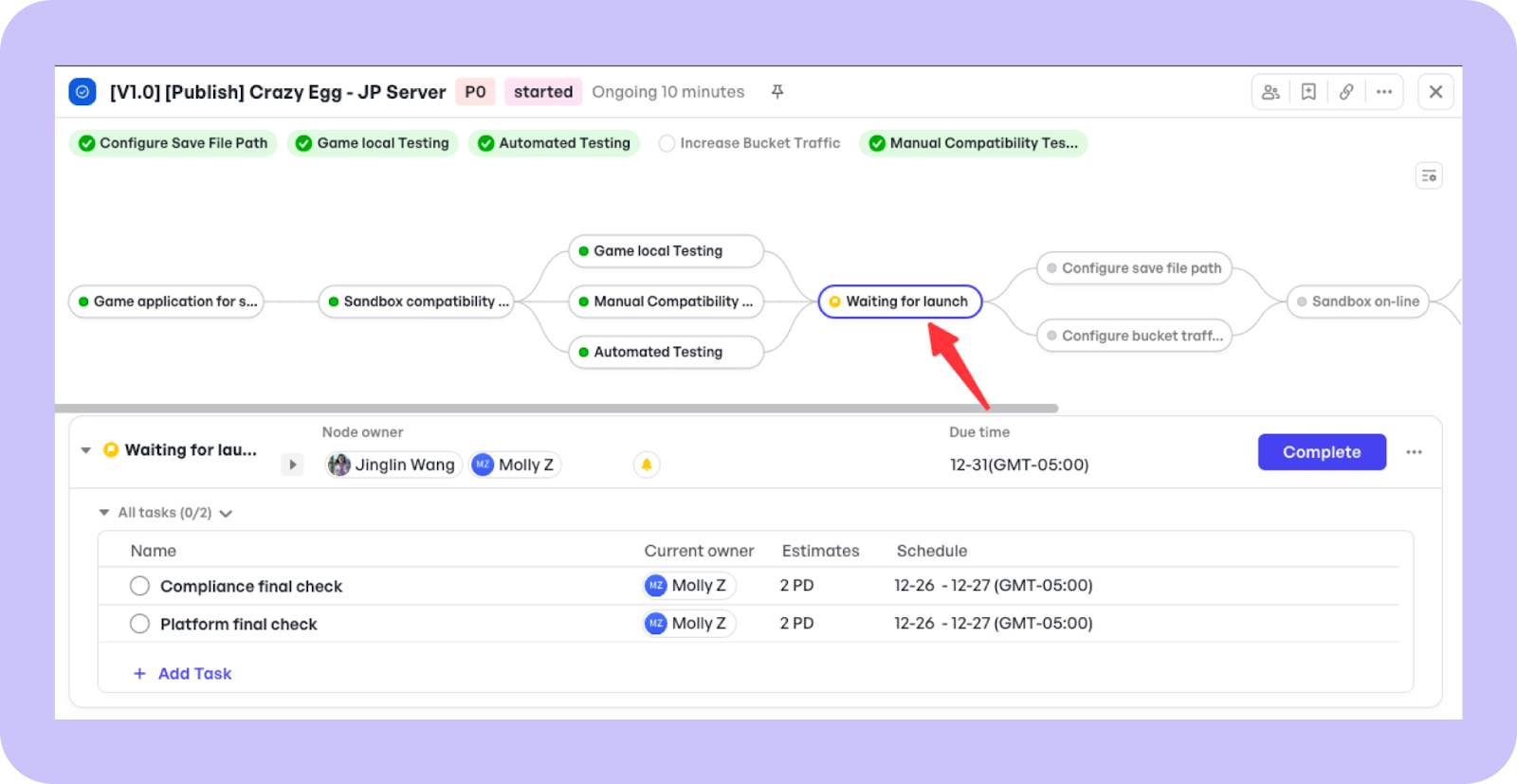 Create project timelines with milestones in Meegle
Create project timelines with milestones in MeegleReal-time dashboards allow teams to track progress, update task statuses, and reassign responsibilities as needed. Teams can also view phase-level milestones and monitor delays to maintain control over delivery schedules.
If you're managing structured projects with fixed timelines and strict accountability, Meegle gives you the control and visibility you need, every step of the way.
Meegle brings order to complex Waterfall projects by helping you align tasks, track progress, and stay on schedule.
FAQs
1. Can Waterfall methodology be used for remote or distributed teams?
Yes. While Waterfall is traditionally associated with co-located teams, it can work for remote setups if supported by tools that enable centralized documentation, visual workflows, and clear task ownership. Platforms like Meegle make this possible by offering shared dashboards and real-time status updates.
2. How do you handle change requests for a Waterfall project?
In Waterfall, changes typically require formal change control. Teams document the request, assess its impact, and may need to revisit earlier phases, such as design or requirements. Using a tool like Meegle allows you to log change requests, link them to affected nodes, and manage approvals through a controlled process.
3. What kind of projects should avoid using the Waterfall model?
Projects with evolving requirements, high user involvement, or continuous iterations, such as mobile app development or UX-heavy platforms, are better suited for Agile or Hybrid approaches. Waterfall works best when scope, goals, and deliverables are clearly defined upfront.
4. Is it possible to combine Agile sprints within a Waterfall structure?
Yes. Some teams follow a Hybrid model where core systems (e.g., infrastructure, compliance-heavy modules) follow Waterfall, while front-end development or integrations are managed in Agile sprints. Meegle allows you to manage both workflows in parallel.
5. How do you measure success in a Waterfall project?
Success is typically measured by adherence to scope, timeline, budget, and quality standards defined in the requirements phase. Milestone tracking, completion of deliverables per phase, and successful test case execution all serve as key performance indicators.
The world’s #1 visualized project management tool
Powered by the next gen visual workflow engineRead More
Check All BlogsStart creating impactful work today



